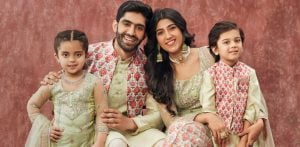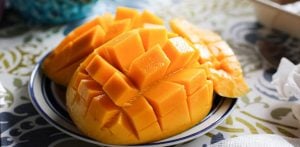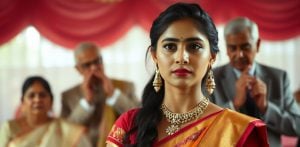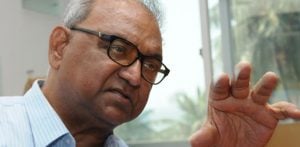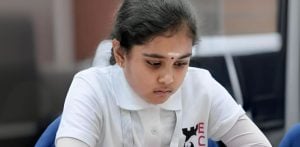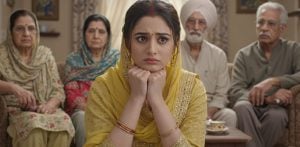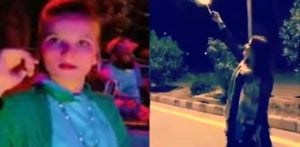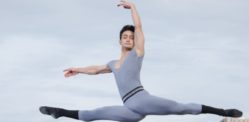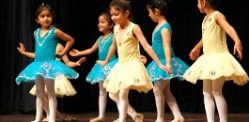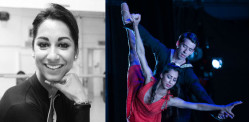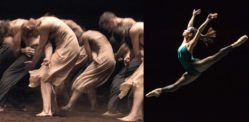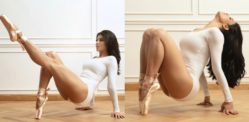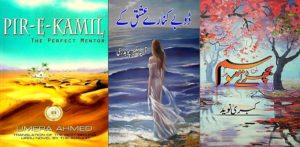Western Ballet and Kathak require rigorous training and discipline.
Western Ballet and Kathak represent two pinnacle forms of dance.
They are distinct in their origins, techniques, and expressions.
Both embody the profound capacity of dance to tell stories, evoke emotions, and celebrate cultural heritage.
These dance forms have evolved over centuries, each carrying its history, traditions, and innovations, making them cherished and practised globally.
In comparing Western Ballet and Kathak, we gain insight into the diversity of dance as a medium for storytelling, cultural expression, and artistic achievement.
Let’s delve into the contrasting yet equally mesmerising worlds of Western Ballet and Kathak.
Origins of Western Ballet
 The origins of Western Ballet and Kathak are deeply rooted in their respective cultures, each with a rich history that reflects the evolution of dance as an art form.
The origins of Western Ballet and Kathak are deeply rooted in their respective cultures, each with a rich history that reflects the evolution of dance as an art form.
Western Ballet originated during the Italian Renaissance in the 15th century, a period of intense cultural and artistic flourishing in Europe.
It began as a courtly dance form, performed by aristocrats during elaborate festivities.
The ballet was initially developed as an entertainment form to celebrate weddings, royal events, or courtly functions, with dancers performing in grandiose settings.
The dance form was further refined in France, especially under the patronage of King Louis XIV, who founded the Académie Royale de Danse (Royal Dance Academy) in 1661.
This institution was pivotal in establishing ballet as a professional art form, standardising its terminology and techniques.
King Louis XIV himself was an avid dancer and took part in ballet performances, earning the nickname “The Sun King” for his role in the ballet “Ballet de la Nuit.”
Ballet spread across Europe, with each country incorporating its own styles and innovations, leading to the development of distinct national traditions.
By the 19th century, Russia became a leading centre for ballet, contributing significantly to its repertoire, technique, and narrative depth.
Choreographers like Marius Petipa and Lev Ivanov created timeless works such as “The Nutcracker,” “Swan Lake,” and “The Sleeping Beauty,” which remain staples of ballet companies worldwide.
The 20th century saw further evolution with the introduction of contemporary ballet, blending classical ballet with modern dance techniques.
Ballet’s early performances were elaborate events that celebrated royal occasions, marriages, and political alliances.
These spectacles were not just about dance but also about demonstrating the power and sophistication of the court.
Ballet reflects the cultural and artistic ideals of the societies in which it developed, emphasising harmony, symmetry, and the human form’s beauty.
Origins of Kathak
 Kathak is one of the eight major forms of Indian classical dance, with origins tracing back to ancient India.
Kathak is one of the eight major forms of Indian classical dance, with origins tracing back to ancient India.
The name “Kathak” comes from the Sanskrit word “katha,” meaning story, and “katthaka” means the one who tells a story.
It began as a narrative dance form performed by Kathakars or storytellers, who used music, dance, and gestures to bring to life stories from Hindu mythology.
There were great Indian epics like the Mahabharata and Ramayana.
Kathak evolved over centuries, flourishing during the Bhakti movement, where it was performed in temples as a devotional expression to the gods.
However, it underwent a significant transformation during the Mughal era in North India.
Under the patronage of Mughal rulers, Kathak was performed in the royal courts.
This led to the incorporation of Persian and Central Asian influences, which added to its grace and elegance.
This period saw the introduction of intricate footwork, spins (chakkars), and the use of facial expressions (abhinaya) to convey emotions and stories.
The dance form is characterised by its fluid movements and rapid footwork matched by the beats of tabla or pakhawaj drums.
Kathak is traditionally divided into two schools or “gharanas”: the Lucknow gharana, known for its emphasis on grace and expression, and the Jaipur gharana.
This focuses more on the technical aspects of dance, such as complex rhythms and footwork.
Both Western Ballet and Kathak have undergone significant transformations over the centuries, adapting to cultural changes and influences while retaining their core elements.
Today, they are celebrated worldwide for their beauty, technical precision, and storytelling power.
Technical Foundations of Ballet
 The ballet technique is grounded in a specific posture that includes turnout (the outward rotation of the legs from the hips), pointed feet, and an elongated spine.
The ballet technique is grounded in a specific posture that includes turnout (the outward rotation of the legs from the hips), pointed feet, and an elongated spine.
This posture is essential for the execution of ballet movements and contributes to the dance form’s aesthetic of grace and fluidity.
Turnout is a fundamental element, turnout involves rotating the legs outwards from the hips, allowing for a greater range of motion and aesthetic lines.
It’s crucial for many ballet steps and positions.
Ballet has five basic positions of the feet and arms, which form the foundation for all movements.
The vocabulary of ballet includes jumps (sautés), turns (pirouettes), and extensions (développés), among others.
Female dancers often perform on pointe, using specially designed shoes to dance on the tips of their toes.
This technique requires significant strength in the feet and ankles and is a hallmark of classical ballet.
Training typically begins at the barre, where dancers practise exercises to develop technique, strength, and flexibility before moving to the centre of the floor.
Technical Foundations of Kathak
 Kathak places a strong emphasis on intricate footwork called Tatkar, with dancers wearing bells (ghungroos) around their ankles.
Kathak places a strong emphasis on intricate footwork called Tatkar, with dancers wearing bells (ghungroos) around their ankles.
The rhythmic patterns created by the feet are a critical aspect of Kathak performance.
Spins, known as chakkars, are a defining feature of Kathak, with dancers executing multiple, rapid turns in succession.
The ability to maintain balance and grace during these spins is a testament to the dancer’s skill.
There is the use of hand gestures, mudras. In addition, there are facial expressions utilised called Abhinaya.
Expressive gestures and detailed facial expressions are used to tell stories and convey emotions, making storytelling an integral part of Kathak.
Kathak dancers often engage in complex rhythmic patterns and improvisation, interacting with the musicians and sometimes even reciting the rhythmic syllables being played or danced.
While ballet narratives are often conveyed through choreographed sequences and mime, Kathak directly incorporates storytelling into its performances.
Dancers narrate tales through dance and expression.
Both forms require years of rigorous training to master the techniques and expressivity inherent in each style.
Though the methods may differ, both ballet and Kathak use dance as a means of storytelling, whether through abstract movements, expressive gestures, or narrative sequences.
Music plays a crucial role in both dance forms, with dancers relying on musical cues for timing, expression, and rhythm.
Western Ballet Costumes
 Costumes play a crucial role in the storytelling aspect of dance, helping to transport the audience into the world being portrayed on stage.
Costumes play a crucial role in the storytelling aspect of dance, helping to transport the audience into the world being portrayed on stage.
In Western Ballet, costumes are designed to complement the elegance, fluidity, and technical precision of the dance.
They vary widely depending on the production, ranging from the opulent and elaborate to the minimalist and modern.
For classical ballets like “Swan Lake” or “The Nutcracker,” costumes often reflect the period setting of the piece, contributing to the historical and thematic authenticity of the performance.
These costumes can be highly detailed, featuring intricate designs that reflect the character’s role and the ballet’s setting.
Ballet costumes are crafted to highlight the dancers’ lines and movements without hindering their performance.
Tutus, for example, are iconic ballet costumes that consist of a fitted bodice and a stiff, outward-projecting skirt made of tulle.
This allows the audience to better see the dancers’ leg movements and the technical aspects of their performance.
Costumes help in distinguishing characters, with different colours and styles indicating various roles, such as the lead dancer, the antagonist, or specific character types like fairies or peasants.
This visual differentiation aids in storytelling and helps the audience follow the narrative.
Kathak Costumes
 Kathak costumes reflect the dance form’s roots in storytelling and its evolution through both the temples and the courts of North India.
Kathak costumes reflect the dance form’s roots in storytelling and its evolution through both the temples and the courts of North India.
They are traditionally elaborate, with a focus on complementing the dance’s rhythmic footwork, spins, and expressive gestures.
Kathak dancers typically wear a long, flared skirt (lehenga), combined with a fitted blouse (choli) and a long piece of cloth draped across the torso or over the head (dupatta).
The costume often features rich fabrics, intricate embroidery, and vibrant colours, reflecting the dance’s celebratory and expressive nature.
Accessories play a significant role in Kathak costumes, with dancers adorning themselves with heavy jewellery, including necklaces, earrings, headpieces, and bangles.
These accessories enhance the visual impact of the dancer’s movements and expressions.
An essential part of the Kathak costume is the ghungroos, or small bells worn around the ankles.
The number of bells can vary, but they serve a critical function in accentuating the rhythmic footwork that is a hallmark of Kathak dance.
While there is a traditional base for Kathak costumes, variations exist that reflect the dancer’s personal style, the specific piece being performed, and regional differences.
These variations allow for a degree of personal expression within the framework of traditional attire.
In both Western Ballet and Kathak, costumes are not just attire but an integral part of the performance, enhancing the storytelling, adding to the aesthetic beauty, and reflecting the cultural heritage of each dance form.
They work in harmony with the music, choreography, and set design to create a complete and immersive experience for the audience.
The Role of Music in Ballet
 The role of music in both Ballet and Kathak is central, not only as a backdrop to the dance but as an integral part of the performance that interacts with and enhances the movement, emotion, and storytelling of each dance form.
The role of music in both Ballet and Kathak is central, not only as a backdrop to the dance but as an integral part of the performance that interacts with and enhances the movement, emotion, and storytelling of each dance form.
Music and dance in both traditions are deeply interconnected, with each influencing the other’s development and expression.
In Ballet, music serves several key functions.
Music in ballet often tells a story or conveys emotions without words.
Composers like Tchaikovsky, Prokofiev, and Stravinsky have created scores for ballets that are narrative-driven, with motifs and themes associated with characters, emotions, and plot developments.
The music guides the audience through the story, enhancing the emotional depth and narrative structure of the ballet.
Ballet choreographers frequently work closely with music, allowing the score to inspire the movements and formations of the dance.
The rhythm, tempo, and mood of the music directly influence the choreography, with dancers’ movements often mirroring the musical phrases and accents.
Music provides the essential timing and rhythm for ballet dancers, ensuring that their movements are synchronised both with each other and with the musical score.
This coordination is crucial for the ensemble pieces where precise timing is essential for the visual harmony of the performance.
Beyond narrative and rhythm, music also sets the tone and atmosphere of a ballet performance, creating a soundscape that transports the audience to another time or place.
Whether it’s the magical ambience of “The Nutcracker” or the tragic overtones of “Giselle,” music is key to establishing the setting and mood.
The Role of Music in Kathak
 In Kathak, music plays a similarly vital role but with unique aspects reflective of its cultural context:
In Kathak, music plays a similarly vital role but with unique aspects reflective of its cultural context:
Kathak music is deeply rhythmic, often centred around the tabla or pakhawaj (drums) that provide the complex rhythmic cycles (talas) foundational to the dance.
Dancers match their intricate footwork and spins to these rhythms, sometimes even engaging in a dialogue with the musicians through improvisation.
Music in Kathak, including both instrumental and vocal compositions, serves to enhance the narrative and emotional expression of the dance.
The lyrics of the songs often relate to the stories being told through the dance, whether they are mythological tales, devotional themes, or expressions of love and longing.
A unique feature of Kathak is the improvisational interaction between dancers and musicians.
Dancers may respond to the music with spontaneous movements, while musicians might alter their playing to follow the dancer’s lead, creating a dynamic and collaborative performance.
The music used in Kathak often has deep cultural and spiritual significance, drawing from classical Indian music traditions.
This connection adds a layer of depth to the performance, grounding it in its cultural heritage and spiritual traditions.
In both Ballet and Kathak, music is not merely an accompaniment but a partner to the dance, shaping and being shaped by the choreography and performance.
It enhances the emotional and aesthetic experience, deepening the audience’s engagement with the dance.
Narrative Techniques in Ballet
 The narrative techniques employed in Ballet and Kathak are both diverse and distinctive, reflecting the cultural, historical, and artistic contexts from which each dance form originated.
The narrative techniques employed in Ballet and Kathak are both diverse and distinctive, reflecting the cultural, historical, and artistic contexts from which each dance form originated.
While both forms are adept at storytelling through movement, they utilise different approaches and techniques to convey narratives, emotions, and characterisations.
Ballet often uses mime and specific gestures to tell stories and express emotions.
These gestures are stylised and codified, allowing dancers to convey complex narratives without words.
For example, a hand placed over the heart might signify love, while a hand extended outward could indicate rejection or farewell.
Ballet incorporates character dances, which are stylised folk or national dances that help set the cultural context of the story.
These dances can provide background for the setting or enhance the narrative by showcasing the heritage or social status of the characters.
Musical leitmotifs, or recurring musical themes, are often associated with specific characters, emotions, or plot elements.
These musical cues support the narrative by reminding the audience of certain characters or themes whenever they are played.
Some ballets employ abstract narration, where the story is not told through a linear narrative but through thematic or emotional exploration.
Movements and formations may symbolise rather than depict events, leaving more to the audience’s interpretation.
Visual elements like set and costume design play a crucial role in storytelling, providing context and enhancing the narrative.
These elements can indicate the setting, time period, and mood, as well as differentiate between characters.
Narrative Techniques in Kathak
 Kathak utilises abhinaya, or the art of expression, to convey stories and emotions.
Kathak utilises abhinaya, or the art of expression, to convey stories and emotions.
Dancers use facial expressions, hand gestures (mudras), and body language to depict characters and narrative scenes.
Abhinaya allows for detailed storytelling, including dialogues and interactions between characters.
Gat Bhav is a technique that involves mimetic action where the dancer enacts scenes or emotions through dance movements.
Gat Bhav can be used to portray various scenarios, from the playful to the devotional, enhancing the narrative through interpretive dance.
Padhant: Kathak dancers often recite or sing the bols (rhythmic syllables) and verses they are dancing to called padhant.
It creates a direct connection between the narrative content and its rhythmic expression.
This vocal element can serve to introduce a story, set a scene, or provide commentary.
Kathak performances may include improvisational passages where the dancer interacts with the musicians, sometimes even engaging the audience.
This spontaneity can add depth to the narrative, allowing for a dynamic and immediate connection with the audience.
While less directly narrative, the elaborate costumes and jewellery in Kathak can indicate the character being portrayed, their status, and the mood or theme of the piece.
The visual spectacle supports the storytelling by enhancing the aesthetic and emotional impact of the performance.
In summary, Ballet tends to emphasise structured choreography, mime, and musical motifs to convey stories, often within a proscenium stage setting that frames the narrative like a living painting.
Kathak, on the other hand, relies heavily on expressive gestures, facial expressions, and direct audience engagement, often breaking the “fourth wall” to make the storytelling more intimate and immediate.
Both forms, through their unique narrative techniques, demonstrate the universal power of dance to tell stories and evoke emotions across cultures.
Western Ballet and Kathak are forms that require rigorous training and discipline, and both have adapted and evolved over time, absorbing influences from other art forms and cultures.
They continue to be performed and celebrated worldwide, not only for their traditional repertoire but also through innovative works that push the boundaries of dance as an art form.
Each form, with its unique aesthetics and values, enriches the global tapestry of dance, giving audiences a window into the complex, beautiful world of human expression through movement.




















